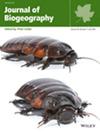Local and Regional, Not Latitudinal, Variation in Microclimate and Bedrock Shapes Moss-Associated Diatom Communities in Greenland
Abstract
Aim
Greenland is among the most rapidly changing regions on Earth, with climate change having a profound impact on its terrestrial ecosystems. Here, moss-associated diatoms hold great potential as sensitive biological indicators to monitor responses to climate change, but their diversity, community structure and biogeography remain virtually unexplored. Our study, thus, aims to (1) explore the diversity and community structure of moss-associated diatoms in Greenland and (2) assess the environmental and spatial variables driving their geographic distribution, establishing a baseline for their use as bio-indicators of climate change.
Location
Greenland, spanning a gradient from high to subarctic regions.
Taxon
Moss-associated diatoms (Bacillariophyta).
Methods
LM and SEM analysis was conducted on 175 terrestrial moss samples collected from preserved herbarium material and fresh samples (1988–2021) from high, low and subarctic localities in Greenland. Biogeographical distributions, biodiversity patterns and community structure were examined in relation to environmental and spatial factors using Kruskal–Wallis, Spearman's Rank, ordination, SIMPROF and variation partitioning analyses.
Results
A total of 544 diatom taxa (66 genera) were identified, with nearly half potentially new to science. Community structure was predominantly influenced by moisture, pH, conductivity and temperature. Local variation in microclimate and bedrock, thus, explained more variation in the diatom communities than latitude-related environmental gradients. Surprisingly, temperature had a negative impact on diatom richness, probably due to its adverse effect on moisture, highlighting the vulnerability of Arctic moss diatoms to global warming.
Main Conclusions
This study provides the first comprehensive analysis of Greenland's moss-associated diatoms, highlighting their high diversity and sensitivity to environmental changes. Our findings underscore their potential as indicators for monitoring climate change in the Arctic, with moisture, pH, conductivity and temperature being critical factors influencing their communities, laying the groundwork for future research and monitoring efforts.

 求助内容:
求助内容: 应助结果提醒方式:
应助结果提醒方式:


